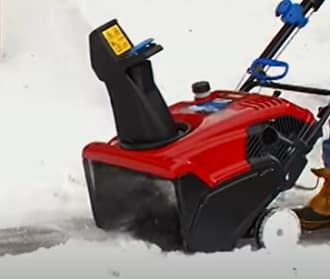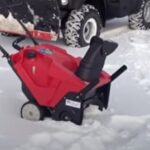As an Amazon Associate, this site earns commissions from qualifying purchases. For more information click here.
There is a wide array of snow blowers to choose from, but the one that a lot of people ask about is the engine. Are snow blowers 4-cycle or 2-cycle engines? And what difference does it make? If you want to get the most out of your snow blower, knowing the engine type is a must. We cover this topic in detail here.
Most snow blowers made today run on 4 cycle engines. If yours is an old model it probably has a 2-cycle engine. The biggest difference is that 2-cycle snow blowers require you to mix gas and oil, while 4-cycle engines store them separately.
Differences between a 2-cycle and 4-cycle Snow Blower
There are many differences between a 2-cycle and a 4-cycle engine. The most obvious is the way they handle oil and gas.
The term stroke refers to how many movements the crankshaft and cylinder have to perform per power stroke. A 2-cycle engine needs one revolution per power stroke while a 4-stroke needs two per stroke.
A 2-cycle or 2-stroke snow blower needs a specific mix ratio of gas and oil (example, 50:1, 40:1, etc.). If you don’t mix the two or the mix ratio is incorrect, the engine will not start. If you somehow got it to start, the engine might stall or suffer some kind of damage.
4-cycle snow blowers do require you to combine gas and oil. If you have difficulty getting the mix ratio right, this engine type is right for you.
This video explains the difference between a 2 and 4 cycle engine. While it focuses on vehicles, these are also applicable to snow blowers.
2-cycle vs. 4-cycle Snow Blowers: Which is Better?
If you are going to buy a snow blower, chances are it has a 4-stroke engine. There might be a few exceptions, but most brands are discontinuing 2-cycle snow blowers in favor of 4-cycle engines. And there are good reasons for this.
For most users the biggest benefit of a 4-stroke snow blower is you don’t have to mix oil and gas. The ratio must be exact otherwise it will affect performance. If the ratio is too far off the blower might not run at all.
If you have been using 2-stroke snow blowers for a long time, mixing is probably not an issue. If you do it enough times you probably have the measurements down pat. But mistakes can happen especially if you are new to this tool.
Because 4-stroke snow blowers do not require fuel mixing, it is easier to use than 2-stroke engines. They are also more energy efficient. One of the better 4-stroke snow blowers out there is the PowerSmart 212cc as it is easy to use, compact but powerful.
Just to be clear: while 4-stroke engines do not mix oil, they still require oil. But you only need to change it every 3-4 months. Whereas with a 2-stroke engine, every time the fuel runs out you have to add a new mix.
Benefits of a 4-cycle Snow Blower
A 4-stroke engine offers many other advantages:
A 4-stroke snow blower runs more quietly than a 2-stroke model. This can make a huge difference if you have to go through a lot of snow.
Less vibration. One of the problems with 2-stroke blowers is their tendency to vibrate. This is less of an issue with 4-stroke engines so they are more comfortable to use.
Convenience. As already mentioned, there is no need to mix oil and gas. It is a convenient feature that makes it attractive to use.
Built to last. A 4-stroke engine is built for efficiency and long term use. Blowing snow takes it toll on u under powered engines and leads to faster wear. A blower running on a 4-cycle engine lasts longer than a 2-stroke, so it is more cost effective.
Environment friendly. 2-stroke snow blowers produce more pollution than a 4-stroke because of the oil and gas mix. A 4-stroke engine offers a more environmentally friendly and efficient solution.
Cost effective. A 4- stroke engine lasts longer and built for heavy duty use. With regular maintenance it is going to last for years. In the long term this means you save money.

Should You Replace Your 2-Cycle Snow Blower?
If you are happy with the performance of your 2-cycle snow blower, there is no reason to replace it. But if you are buying a snow blower or want to replace that old model, get a 4-stroke blower. One that we can suggest is the PowerSmart PS21 because it is intuitive to use and handles a lot of snow.
We have already pointed out the benefits of a 4-stroke engine. In addition there are also drawbacks with 2-stroke models.
The biggest problem with 2-stroke snow blowers is they are being phased out. They are still available but will disappear sooner than later.
If you still use a 2-stroke blower and it breaks down, finding spare parts is going to be hard. Eventually those parts will become rare and expensive. Given the drawbacks with these models, it makes more sense to get a 4-cycle engine.
Another reason to switch to a 4-stroke snow blower (if you haven’t already) is it is easier to start. A 2-stroke engine needs to be primed, but a 4-stroke does not. Combine ease of startup with fuel efficiency, and it is easy to see why 4-stroke engines are the norm now.
Is My Snow Blower a 2 or 4-cycle Model?
Majority of snow blowers made from 2012 and later run on a 4-stroke engine. The operating manual also indicates whether the blower is a 2 or 4-cycle engine.
If you no longer have the manual, there are other ways to distinguish a 4-cycle from a 2-cycle engine. If the engine has a dipstick, it is a 4-stroke. Look also for a valve housing marked OHV which stands for over head valve.
If you see either or both, that means the blower runs on a 4-cycle engine. If both are missing, the engine is a 2-stroke.
Those are usually enough to tell the difference between a 2 and 4-cycle engine. But you can also tell fro their performance what type of engine is being used.
A 4-stroke snow blower does not produce any smell. Most of them, including Honda snow blowers, do not generate smoke either. If you have ever used a 2-stroke blower before, you know how much smoke and gassy smells they produce. With a 4-stroke engine this will not happen.
Frequently Asked Questions
What fuel does a 4-stroke snow blower use?
4-stroke engines run on the same gas as any vehicle. The ethanol level cannot be more than 10% however. You can use regular unleaded gas as well.
What happens if you mix oil and gas in a 4-stroke snow blower?
This can cause internal engine damage. The same thing will happen if you use 4-stroke fuel in a 2-stroke engine. Only use fuel that is meant for a specific engine type.
What is the difference between a 4-cycle and a 4-stroke engine?
These terms refer to the same engine type. They are interchangeable.
Can you use a 4-stroke engine without oil?
No. A 4-cycle snow blower does not mix oil. But you have to add oil to the engine. The oil and gas are kept separate though. While a 4-stroke engine still needs oil, it uses much less than a 2-stroke engine.
What happens if I run a 4-stroke snow blower without oil?
Two things. Either the engine does not start or it blows up. Do not attempt this. This is going to cost a lot of money to repair.
Why is my 4-stroke snow blower not running?
The most likely reason is a dirty air filter, lack of fuel or a worn out engine component. If the engine is making weird sounds or struggling to catch, turn the machine off. Look for and fix the problem before trying it again.
Why is a 4-stroke engine more efficient than a 2-stroke?
It all comes down to fuel usage. A 4-stroke snow blower uses less fuel, so it is more efficient and saves money. It can run on regular gas so you do not have to spend extra on premium fuel concoctions.

I love the outdoors and all the tools for maintaining gardens, yards and lawns. The only thing I am more passionate about is sharing what I know about garden and outdoor equipment.


